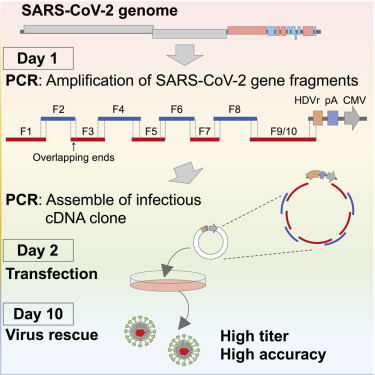
COVID-19: Osaka University artificially synthesizes mutant virus: shortened to 2 weeks
Institute for Microbial Diseases, Osaka University:
Professor Zenji Matsuura Team:
It uses the same technique as the PCR test.
We have succeeded in artificially creating a new type of coronavirus.
In the past, it took several months to create the new coronavirus.
Using this method, it can be shortened to just two weeks.
Mutant viruses can also be created quickly.
Research on new corona treatments is expected to accelerate.
(Yomiuri TV) –Yahoo! News
https://news.yahoo.co.jp/articles/4f59d37131ea3faa3d4b355c1c1254b05b471c3e
Osaka University: Developed new coronavirus artificial synthesis technology that is quick and easy
-Matsuura Lab announced in Cell Reports-
Osaka University
Microbial Disease Research Institute
Researcher Shiho Torii
Zenji Matsuura Specially Appointed Professor
Hokkaido University
Professor Takasuke Fukuhara
Use the Circular Polymerase Extension Reaction (CPER) method.
In two weeks, we established a new technology for artificially synthesizing the new coronavirus.
The new technology significantly reduces “virus synthesis, which used to take months.”
Rapid analysis of mutant viruses:
You can quickly analyze “a new type of coronavirus with mutations that appears all over the world”.
Also,
In genetically engineered virus research,
For example, artificially incorporating a foreign gene
It can be applied to pathogenicity analysis and treatment development.
This technology is expected to play a central role in new corona research in the future.
Artificial synthesis of SARS virus:
Conventional problems:
The development of the SARS virus requires complex and advanced genetic engineering techniques and a period of several months.
In the past, there was the problem that “only a limited number of researchers can artificially synthesize coronavirus.”
This time for mutant virus:
This time, we have developed a technology to quickly and easily produce an infectious virus.
With this technology, it is possible to deal with mutant viruses, elucidate their pathogenicity, and develop treatments.
With this technology, any gene mutation can be introduced quickly and easily.
Utilization of CPER method:
By using the CPER method
Without using advanced genetic engineering technology
Only by PCR, of the new coronavirus
We have found that we can create infectious DNA clones.
In addition, such as GFP,
Viruses that have introduced fluorescent protein,
Viruses with mutated arbitrary genes
It was shown that it can be created.
Osaka University Institute for Microbial Disease RIMD
http://www.biken.osaka-u.ac.jp/achievement/research/2021/152
Establishment of a reverse genetics system for SARS-CoV-2 using circular polymerase extension reaction
Highlights
A quick PCR-based reverse genetics system is established for SARS-CoV-2
SARS-CoV-2 recombinants harboring reporter genes or mutations can be generated
Summary
SARS-CoV-2 has been identified as the causative agent of COVID-19.Although multiple mutations
have been observed in SARS-CoV-2, functional analysis of each mutation of SARS-CoV-2 has been limited by the lack of convenient mutagenesis methods.In this study,
we establish a PCR-based, bacterium-free method to generate SARS-CoV-2 infectious clones.Recombinant SARS-CoV-2
could be rescued at high titer with high accuracy after assembling 10 SARS-CoV-2 cDNA fragments by circular polymerase extension reaction (CPER) and transfection of the resulting circular genome into susceptible cells.The construction of infectious clones for reporter viruses and mutant viruses
could be completed in two simple steps: introduction of reporter genes or mutations into the desirable DNA fragments (∼5,000 base pairs) by PCR
assembly of the DNA fragments by CPER.This reverse genetics system may potentially advance further understanding of SARS-CoV-2.
ScienceDirect
https://www.sciencedirect.com/science/article/pii/S2211124721003284